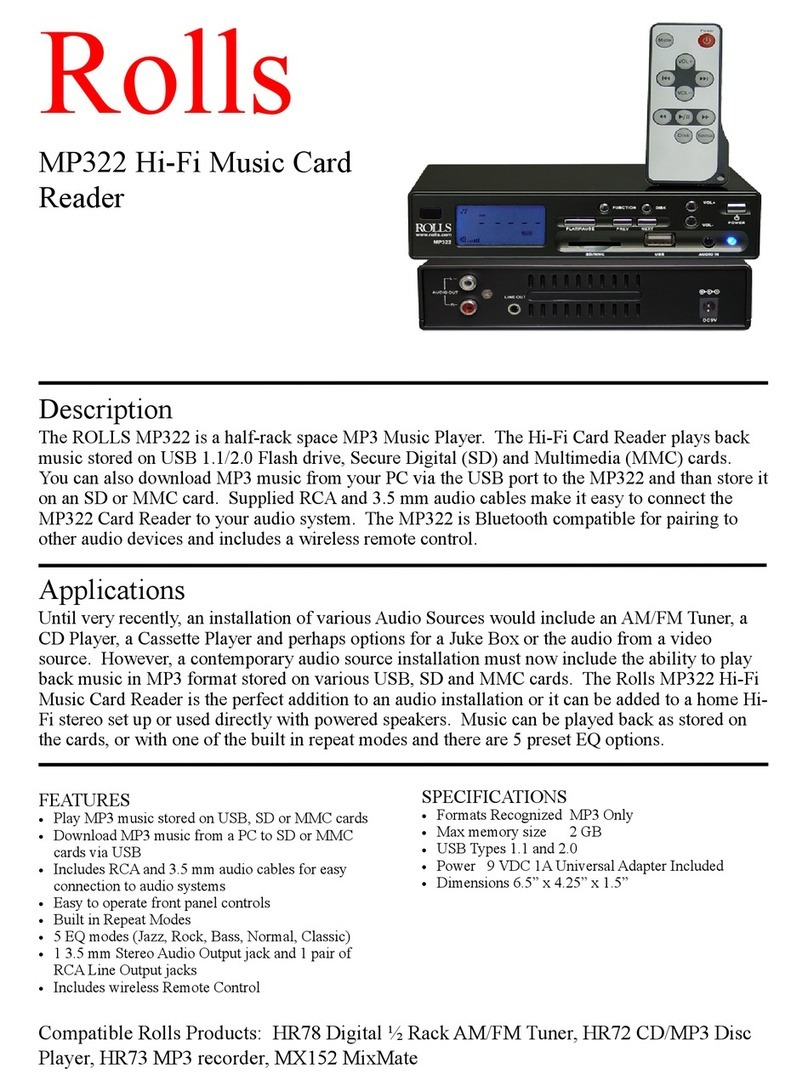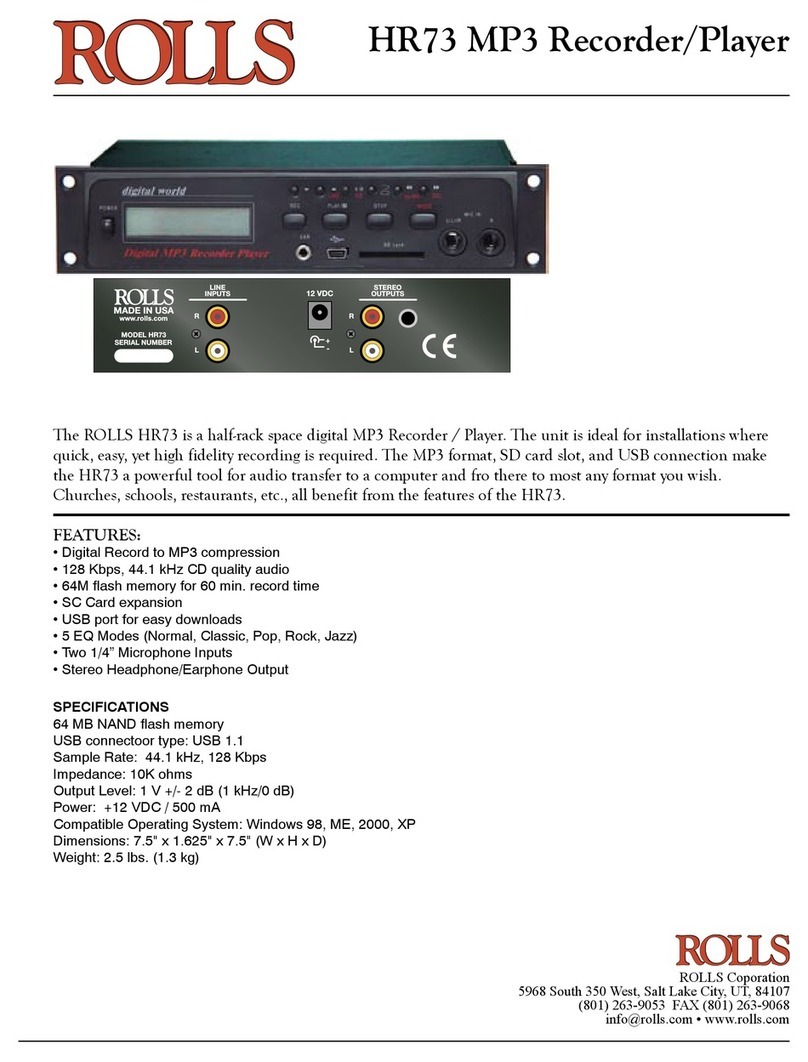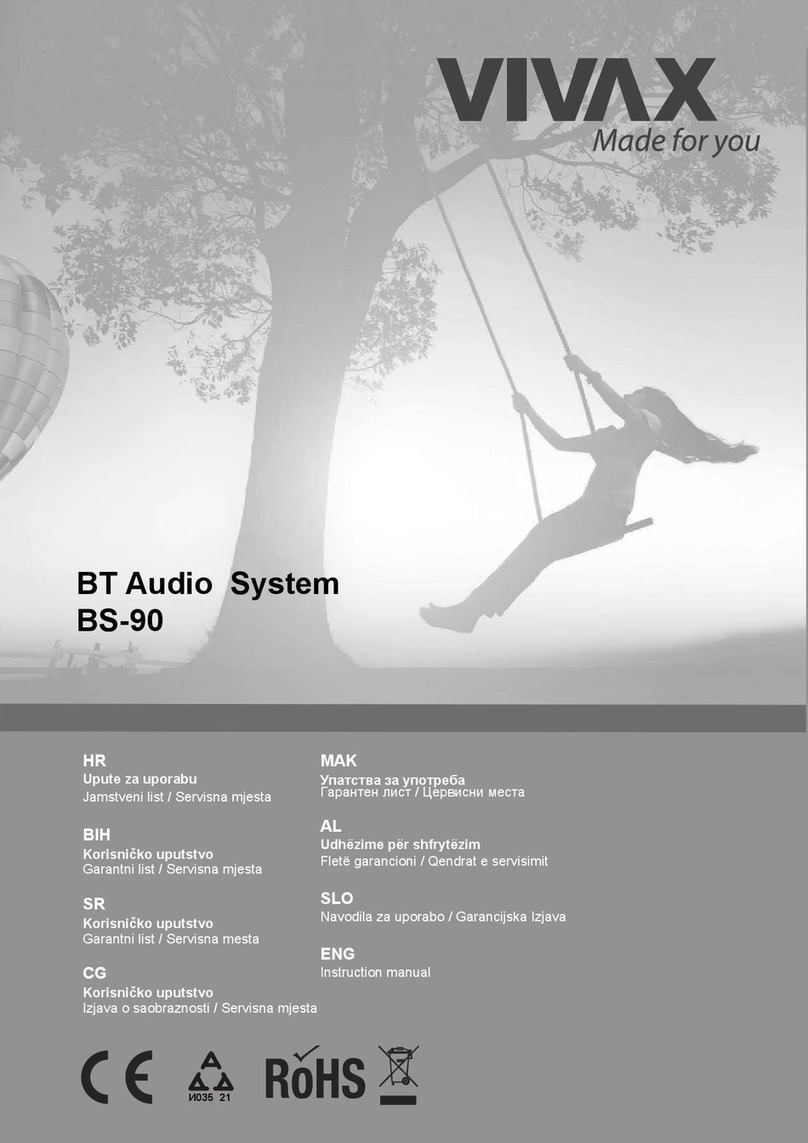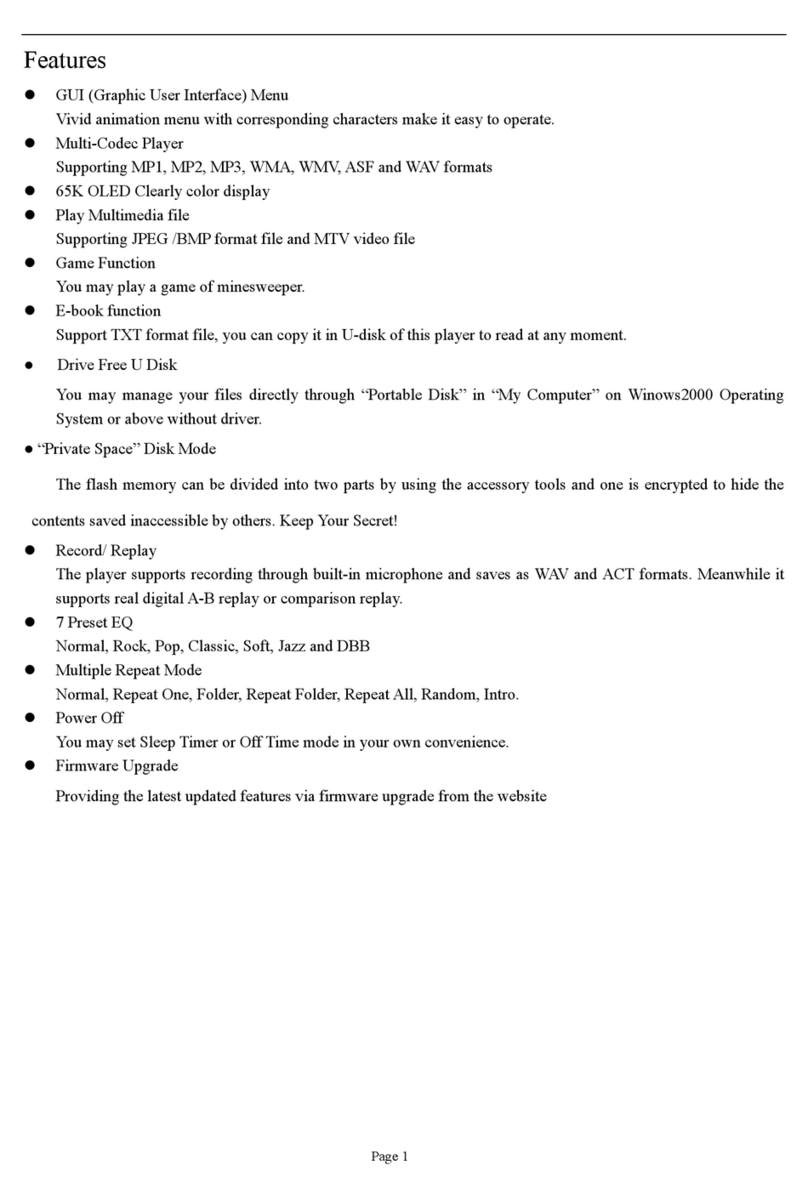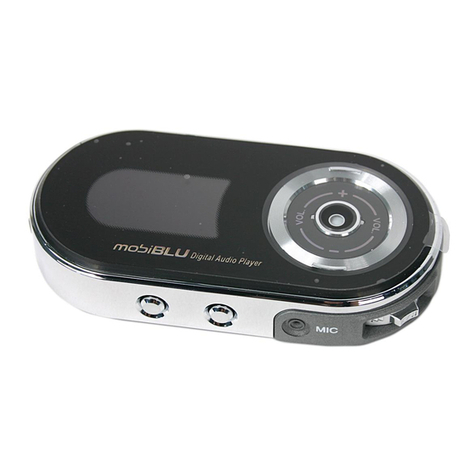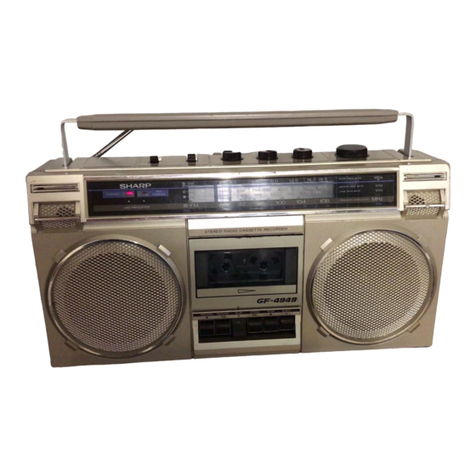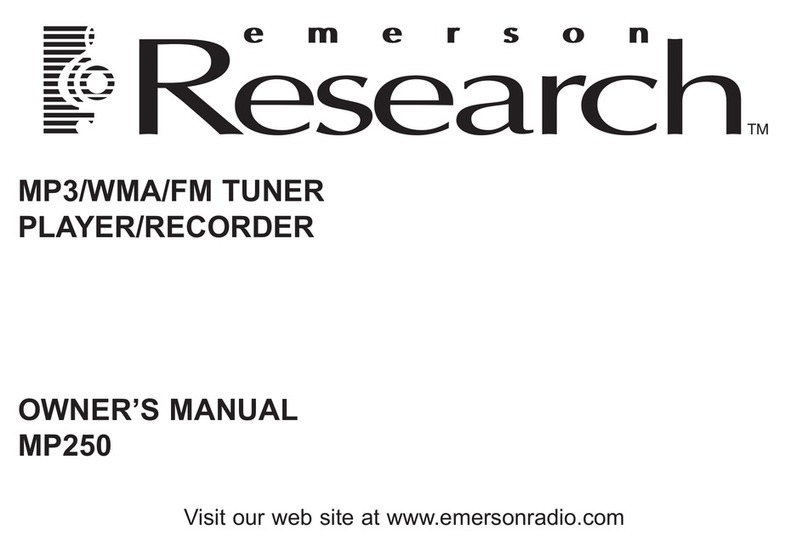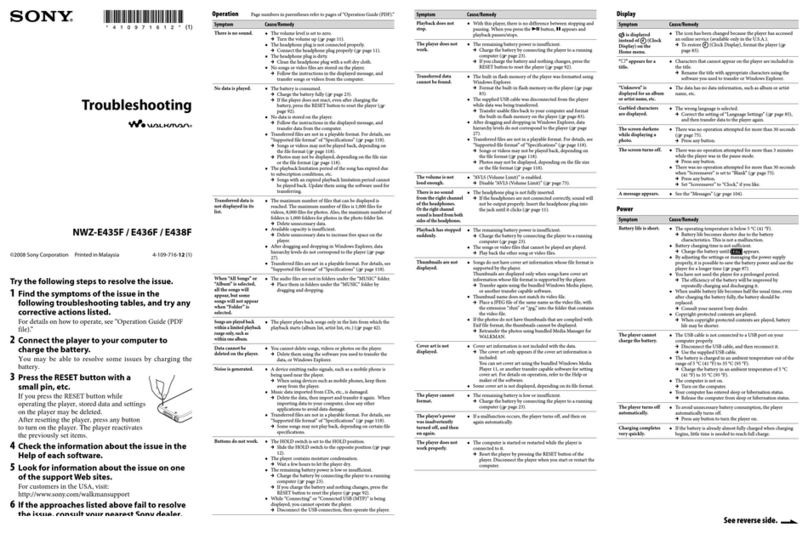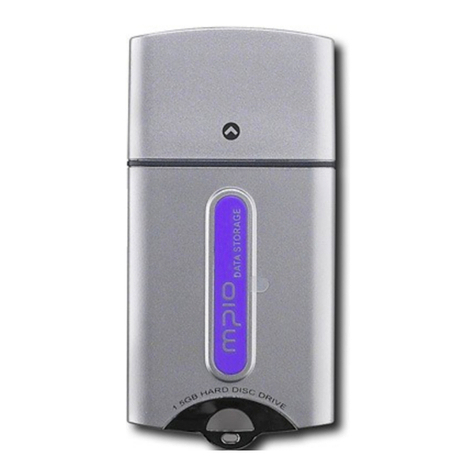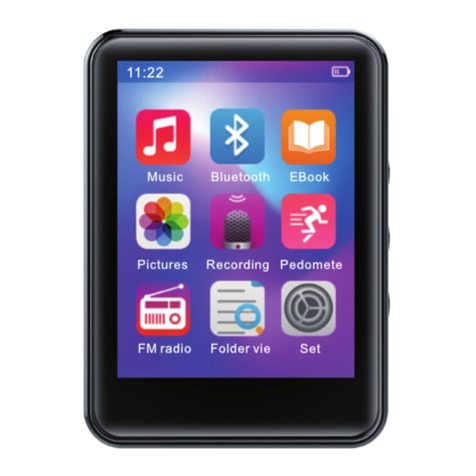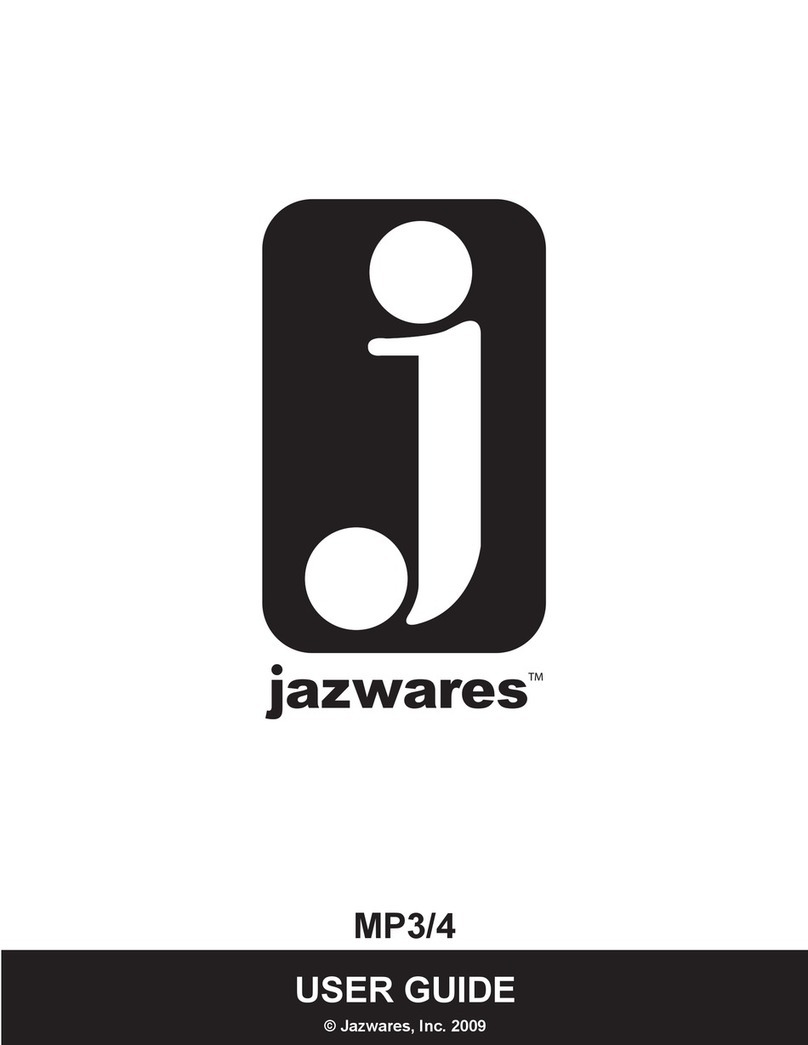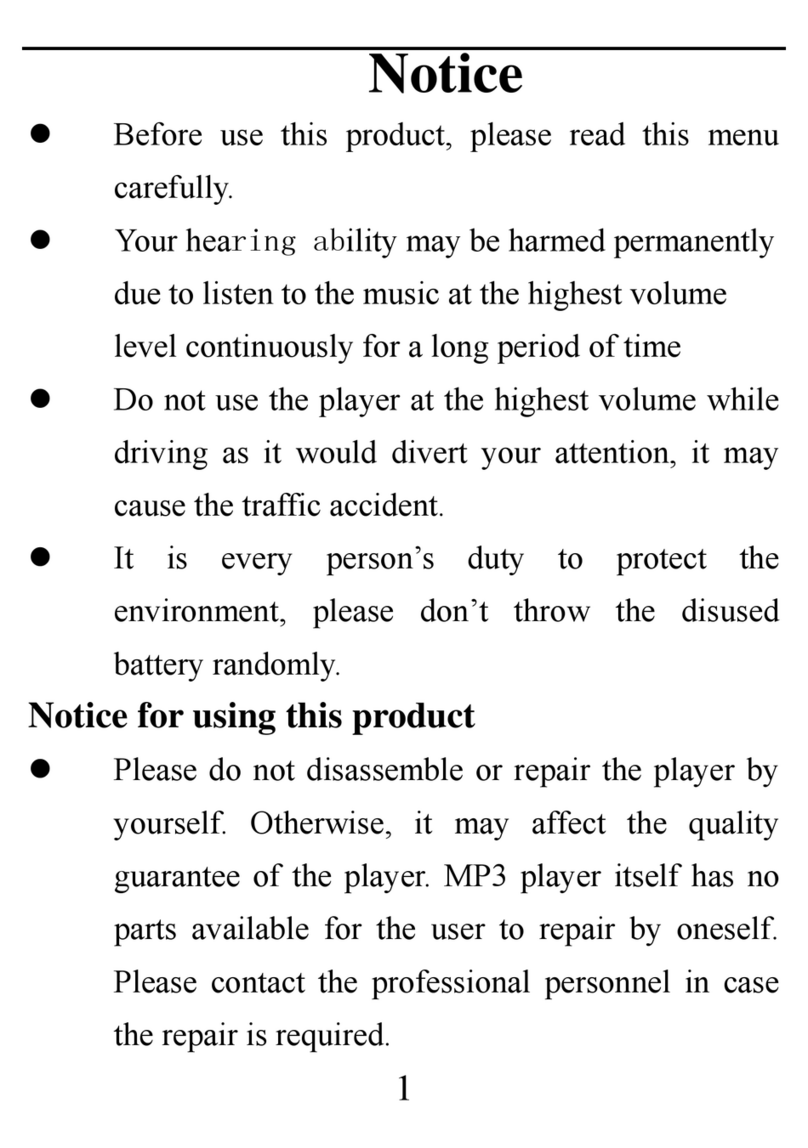Rolls RMS273 User manual

OPERATION GUIDE
HR73 / RMS273
MP3 Recorder
Rolls Corporation
Salt Lake City, UT
04/08
SPECIFICATIONS
Min Input Impedance: 600 Ohms unbalanced
Output Impedance: 1K Ohms line, 16 Ohms EARphone
Digital Record: MP3 Format
Sample Rate: 44.1 KHz, 128K bps (CD quality)
Internal Memory: 64M NAND flash
External Memory: SD Card slot (cards not included)
Memory Access: USB connector type USB 1.1
Compatible Operating System: Windows 98, ME, 2000, XP
EQ Modes: 5; Normal, Classic, Pop, Rock, Jazz
Inputs: Stereo RCA, 2: 1/4' unbalanced Mic in
Outputs: Stereo RCA, 1: 1/8" (3.5mm) EARphone
Power: +12 VDC - ROLLS PS27
Current Consumption: < 350 mA
Size: 8.625" W x 1.75" H x 8" D
Weight: 2.5 lbs (HR73 / RMS273 alone)
Congratulations, and thank you for your purchase of the HR73/RMS273 MP3
Player-Recorder. Please review this guide carefully to ensure proper opera-
tion.
WARRANTY INFO
Please visit our website; www.rolls.com, for complete information on the
Rolls Warranty, and to register and initiate this product's warranty.
USB OPERATION / FILE MANAGEMENT
Please be aware that if you are connecting this unit to a computer with an operating system of
Windows 98 or below - you must visit our website at www.rolls.com to download and install the
USB driver.
Windows XP recognizes, and automatically installs the driver, and will recognize the MP3 Re-
corder. Once the USB cable is connected, the MP3 Recorder internal memory is displayed as
one drive. If an SD card is installed - it comes up as a separate drive. For example; the internal
memory might be drive D, and the SD card assigned drive E.
NOTE: The front panel buttons (except the POWER switch) of the MP3 Recorder do not function
when the unit is connected via USB to a computer.
VOC Mode files
In order for files to be accessed in VOC mode, they MUST be stored in the following format:
M_INT_XX.mp3 for internal memory
M_EXT_XX.mp3 for external or SD card storage.
XX stands for the track number - these must be .mp3 files for playback.
MP3 Mode files
.mp3 files may be stored in either memory (internal or SD card) without renaming them, but they
may only be accessed in MP3 Mode.
Maximum memory for the internal drive is 64M, maximum memory for the SD drive is 512M.
To DELETE files - select the file you wish to delete, press the MODE button and press the ">>
DEL" button. The display will read, "dEL". To delete the file, press the ">>/DEL button again.
PLAYBACK
To switch from internal memory, to SD card memory press MODE, then the STOP button. There
is a one to two second delay while the unit switches memory.
Make sure all proper connections are made; Line Outs are connected to a mixer or amplifier,
the EAR out is connected to stereo earphones or headphones. Please note that there is no level
control on the HR73/RMS273 and that program material may be loud.
To switch from internal memory, to SD card memory press MODE, then the STOP button. There
is a one to two second delay while the unit switches memory.
Select the track you wish to listen to, press the PLAY button to begin playback. If you wish to
change the Equalizer settings, press the STOP button to stop playback. Press the MODE button,
then press the A-B/EQ button repeatedly until you reach the desired EQ setting. Press MODE to
exit and return to normal mode.
If you wish to hear a certain portion of the program material repeated; begin playing the track,
when the material reaches the beginning of the part you want repeated, press the A-B button.
When the material reaches the ending of the part you want repeated, press the A-B button
again. This portion of the material will then playback repeated continuously until either the A-B
button is pressed again, or the STOP button is pressed.
Remember; only files in the VOC format may be played back in VOC mode, all other mp3 files
will be played back in MP3 mode.

DESCRIPTION
FRONT PANEL
• POWER: When pressed in, applies power to the RMS273 / HR73
• LCD DISPLAY: Indicates the Track, Play, Record, Time, and other function status. See MP3 Recorder
Display information located on the next page.
• ▼ Button: Decrements the Track Number - operates quickly when held in (except in MP3 mode).
• ▲ (LINE) Button: Increments the Track Number - operates quickly when held in (except in MP3 mode).
In MODE operation, this button selects the Line Input for recording.
• A-B Button (EQ): Starts and Stops the A-B repeat playback operation. In MODE operation, this button
selects between the different Equalizer settings.
• Repeat Mode Button: Selects the playback repeat. When the single arrow is displayed in the LCD
display, the current track will repeat, when both arrows are displayed, all tracks will play and repeat.
When neither arrow is displayed, the current track will play and stop. NOTE: The repeat all function
does not operate in VOC mode.
• < < Rewind Button (Vo/M3): This button is pressed and held during Play mode to rewind through the
track. In MODE operation, the button selects between VOC and MP3 file selection (MODE operation
is then exited).
• > > Forward Button( DEL): This button is pressed and held during Play mode to fast-forward through
the track. In MODE operation, this button deletes the current track.
• REC: When pressed begins the recording process. When the memory is almost full, the display will
begin to count down (30, 29, 28... etc. to 5,4,3,2,1 and then automatically stop. You MUST select a
blank track. If there is material on the selected track, the display will show three lines.
• PLAY/ II (pause): Begins playing the current track - also pauses the track at the current location.
• STOP: Stops playback and recording. In MODE operation, this button selects between the internal
Flash memory, and the external SD Card memory.
• MODE: Enables the special MODE functions (ie; LINE recording, EQ selections, etc.). If no selection
is made within 5 seconds, the unit returns to normal mode operation.
• Ear Output: 1/8" (3.5 mm) output jack for connection to stereo earphones or headphones.
• USB Connector: Connects via USB cable to a computer's USB port.
• SD Card Slot: Accepts SD memory cards (up to 512 M)
• L/L+R R Mic Inputs: 1/4" unbalanced microphone level inputs.
REAR PANEL
• LINE INPUTS: Two RCA (stereo) line level Input jacks.
• Power Jack: Connects to the enclosed Rolls Power Adapter.
• Stereo Outputs RCA: Unbalanced RCA outputs.
1/8" (3.5mm): Stereo Line/Headphone Output
DISPLAY
• Track Number: Indicates the current track
that is playing or being recorded onto.
• Track Play Status: Indicates the status
of the current track (Record; circle, Play;
triangle, and Pause; dual lines)
• MODE INDICATOR: Indicates the MP3
Recorder is in MODE operation and the but-
tons indicated with red lettering will perform
those functions.
• Equalizer Presets: Shows the five prest
equalizer settings.
• A-B and Repeat Status: Indicates whether
the playback will repeat between two set A and B points, repeat one track, repeat all tracks, or play-
through all tracks once then stop.
• Track Time, USB Status, DELETE indicator: This area will indicate the current track time when play-
ing or recording, indicates USB status (usb connected and data transfer), and the delete status of the
current track.
• Voc or MP3 Mode Indicator: Indicates whether the MP3 Recorder is in VOC or MP3 mode.
• Line In Indicator: Indicates whether the MP3 Recorder is receiving the signal from the front panel
Mic inputs (no LINE IN indication), or the rear panel Line In inputs (shows LINE IN status).
• Flash or Card Memory Indicator: An "F" before the Track Time indicates the program material is
stored in the MP3 Recorder's internal Flash memory. A "C" in that place indicates the material is
stored onto the SD Card.
• Track Time: Indicates the current track recording or playback time.
RECORDING TO INTERNAL MEMORY:
Recording from the Line Inputs
If "Line In" is not already shown in the display, press MODE then the UP/LINE button The display
should indicate "LINE IN". Make sure a blank track is selected. Press REC, and send a signal to the
MP3 Recorder. The circle next to the track number will blink twice, then recording begins. Keep this
delay period in mind so you don't lose program material at the beginning of a track. When you are
finished recording, press the STOP button. These files are automatically saved as VOC files, and are
in the format indicated on the last page of this guide (there is no recording in MP3 mode).
Recording from the Mic Inputs
If "Line In" is indicated in the display, press MODE then the UP/LINE button to enable the MIC INputs
on the front panel. Connect your microphone(s). Proceed as indicated above in "Recording from the
Line Inputs".
RECORDING DIRECTLY TO AN SD CARD:
-To record directly to the SD card the HR73 must be in VOC mode for both recording and playback.-
After an SD card is inserted the display will indicate the letter "C" to varify that an SD card is present.
Select VOC mode on the display. Select a track (1-99) to record to. If the track is already filled you
must first delete the track to record. All other functions of recording are as stated above (there is no
recording to the SD card in MP3 mode).
IMPORTANT NOTE FOR SD CARD RECORDING:
The SD card when recorded to directly with the HR73 will split the card into two seperate sections
MP3's and VOC's both are explained on the last page of this manual. If the SD card had MP3 files on
it they will remain the same after using the HR73 to record directly in VOC mode you will end up with
both MP3's and the VOC files on the SD card. Playback of MP3's can only be done when the HR73
is set to MP3 mode also VOC files can only be played back in VOC mode.
A NOTE ON RECORDING LEVELS: The HR73/RMS273, like all digital recording devices, performs
at its best with a maximum input signal without clipping. This means that a weak, low-level recorded
signal will likely have artifacts or noticeable noise on it.
This manual suits for next models
1
Table of contents
Other Rolls MP3 Player manuals
